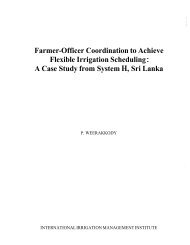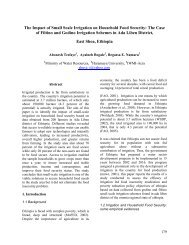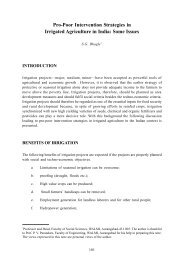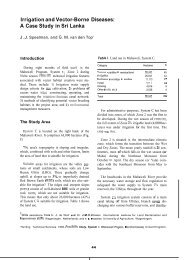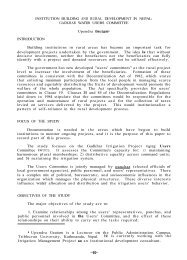WATER POVERTY IN THE NORTHEASTERN HILL REGION (INDIA)
WATER POVERTY IN THE NORTHEASTERN HILL REGION (INDIA)
WATER POVERTY IN THE NORTHEASTERN HILL REGION (INDIA)
Create successful ePaper yourself
Turn your PDF publications into a flip-book with our unique Google optimized e-Paper software.
<strong>WATER</strong> <strong>POVERTY</strong> <strong>IN</strong> <strong>THE</strong> NOR<strong>THE</strong>ASTERN <strong>HILL</strong> <strong>REGION</strong> (<strong>IN</strong>DIA): POTENTIAL ALLEVIATION THROUGH MULTIPLE-USE <strong>WATER</strong> SYSTEMSpoverty mapping combines the strengths of the Water Poverty Index (WPI) as a composite measureof water poverty, with that of poverty mapping and geographic targeting as a way of allocating scarceresources more efficiently than traditional means tested, universal or other methods for identifying themost water-poor households and communities (Cullis and Gorgens, 2006).The objective of this study is to utilise the Water Poverty Index (Lawrence, Meigh and Sullivan, 2002)to estimate the extent and target the households affected by water poverty. Water Poverty Index and thesubsequent water poverty mapping is intended to act as a framework for a policy tool that can be usedto monitor the current or future state of water poverty in the region. The details of the components ofthe water poverty map will vary depending on the definition of water that is being considered and thespecific purpose for developing the WPM.3.1. Water Poverty IndexWater Poverty Index (WPI) is designed as a holistic tool to capture the whole range of issues which relateto water resources availability and their impacts on people (Sullivan, 2005). A conceptual frameworkof water poverty was developed in consultation with scientists, water practitioners and researchers atIWMI. The result was a definition of water poverty according to five key components:i. Resource: The physical availability of water supplied, taking account of the variability and qualityof the resource as well as the total amount of water.ii.Access: This implies access to water for human use, accounting for not only the distance to a safesource but also the time needed for collection of a household's water and other significant factors.Access means not simply safe water for drinking and cooking, but water for livestock, irrigatingcrops or for industrial use.iii. Capacity: Capacity implies the effectiveness of people's ability to manage water. It is interpretedin the sense of income to allow purchase of improved water, and education and health, whichinteract with income and indicate a capacity to lobby for and manage a water supply.iv.Use: The ways in which water is used for different purposes; it includes domestic, livestock,agricultural and industrial use.v. Environment: An evaluation of environmental integrity related to water and of ecosystem goodsand services from flora and fauna in the area.These five components are based on the theoretical foundation that poverty is a relative concept and isdefined by capability deprivation leading to a failure to command access to a sufficient water supply tomaintain a healthy livelihood. The five components of the WPI recognise that any measure of water povertymust include not only the physical availability of the resource, but also the socio-economic, political andenvironmental entitlements that govern a person's ability to command a secure and sustainable access tothe resource. Water poverty, therefore, encompasses a number of factors such as water availability, accessto water, capacity for sustaining access, the use of water and the environmental factors which impact onwater quality and the ecology which sustains the water resource.8



